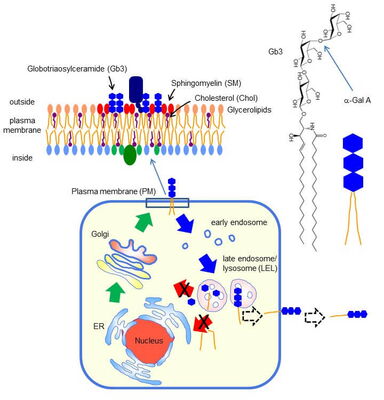Characterization of the plasma membrane lipid organization in Fabry disease

Fabry disease is a lysosomal storage disorder. Little is known about the molecular mechanisms of this disease. The project in the field of biology seeks to examine the plasma membrane lipid organization in Fabry cells. The team will also investigate the role of alteration of lipid organization on cell surface-mediated signaling events. Successful results of this project will provide plasma membrane lipids and lipid organization as a new therapeutic target of Fabry disease. The project is supported by Eucor – The European Campus in the “Research and Innovation” category of the Seed Money scheme.
Legende of the figure: Globotriaosylceramide (Gb3) biosynthesis occurs in ER and the Golgi apparatus. Gb3 is then transported to the plasma membrane (PM) (green arrows) where Gb3 may interact with sphingomyelin (SM), a major sphingolipid in mammalian cells, and cholesterol (Chol) to form specific lipid raft domains. Cell surface Gb3 is constitutively endocytosed to late endosomes/lysosomes (LEL) (blue arrows). There, Gb3 is degraded by the enzyme alpha-Gal A. This digestion triggers the total degradation of Gb3 to various components. These components are re-utilized by cells (red arrows). Fabry cells lack alpha-Gal A and thus inhibit Gb3 degradation and re-utilization of the lipid components. Accumulation of Gb3 in LEL may change physical and biological properties of the organelle. Fabry cells also accumulate lyso-Gb3 (globotriaosylsphingosine), an unusual lipid. Lyso-Gb3 is transported to the PM and then secreted by an unknown mechanism (black dot arrow).
This project is now closed. You can find out more about its implementation here:
Characterization of the plasma membrane lipid organization in Fabry disease: Summary [128.4 KiB]Contact:
- Strasbourg: Toshihide Kobayashi
- Freiburg: Winfried Römer